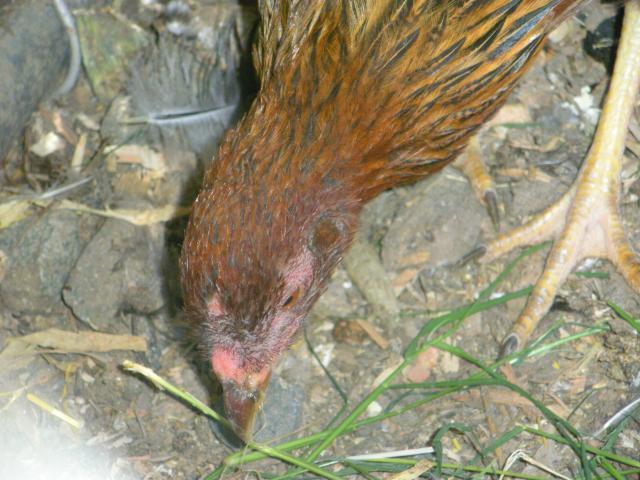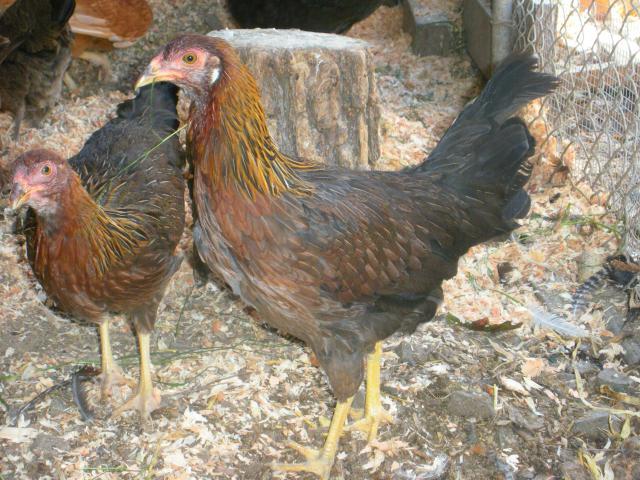Oh, here's a copy of the unofficial European standard for the Kraienkoppe. Found it on a link that Gallo sent me. You might have seen it before...
The Kraienkoppe Breed Standard:
Origin: In the Bentheim area, both sides of the German/Dutch border. 1925 was the first time it was shown in Germany.
Breeding Goal: An early maturing laying hen with 180-200 eggs in the first year of lay, 150-160 in the second year; non-broody; very rich in tender white meat; minimum weight for hatching eggs is 58-60 grams; shell colour: white to tinted.
General Impression: A sleek, powerful type of country chicken, giving the impression of a game bird; especially in the head, and then carriage, and thighs; the tail that is set wide and carried attached; tight feathering, which gives them protection from moisture; feathers on both sides of the quill are narrow; a trusting but very lively temperament.
Standard weights: Rooster (2.5-3.0 kg), Hen (2.0-2.5 kg).
Breed Characteristic: Rooster
Trunk: powerfully built, sleekly elongated, with broad shoulders, upright, elongated carriage; hold themselves like a game bird.
Back: good, medium-long, straight, barely narrows from the powerful, wide shoulders to the back; lightly slopes, with a wide, rich (but not too long) saddle.
Tail: A bit more than medium-long, with a pronounced tail angle; it carries the feathers lightly spread, with a lot of rounded, hard-shafted sickle feathers which lean toward the body in a beautiful semi-circle; set wide.
Breast: wide, full, carried somewhat high and bulging slightly towards the front.
Stomach: pretty wide, fully developed.
Wings: pretty long, slightly open, but not carried lose/floppy; they lay close to the body; the wing tips are under the saddle feathers.
Head: short, wide, rounded, with small brow ridges, and a mares neck (Translators note: where the hackle feathers curve out from the head, like a mane like a good Orloff rooster)
Face: red, fine skinned, free of feathers, short.
Eye: vivacious, fiery, yellow-red to red, deep set.
Beak: short, strong, yellow; horn-striped
Comb: not too narrow, laying well on the head, a knot of flesh on the front part of the skull; in the shape of a half, rather long strawberry; shouldnt go on past middle of eye; in a well-bred specimen it has tiny points.
Ear lobes: small, red.
Wattles: very short, do not obscure the red throat.
Throat: A little more than medium-long, powerful; feathers are not too long in the hackle; the hackle really highlights the mares neck, and does not cover the shoulders due to the short feathers.
Thighs: muscular, pronounced forward placement with smooth feathers.
Legs: good; medium-long, slim; unfeathered, yellow without red stripes.
Feathers: tight, no fluffy or loose plumage.
Breed Characteristics: The Hen
The powerful, slender trunk is carried almost horizontal; she shows a well-developed laying stomach that reaches far toward the back; a tail that is carried slightly open (spread), easily visible thighs, hard plumage, the comb is pretty small; wattles almost invisible; ear lobes small and red -- if pale like a game bird, this is not a fault.
COLOUR STANDARDS
(For good pictures of specimens of the colour names, see
http://www.gefluegel.org/kenn.html)
Silberhalsig Rooster: Head: white; hackle is silver-white with pronounced black shaft line; back, shoulders and saddle are pure silver white, but with pronounced shaft lines; the wing covers are silver-white; cover feathers (Binden) are black with green sheen. The secondaries are white on the outside, but black on the inside and tip; the primaries are black with narrow white outer edges; the breast, stomach, and thighs are black; the tail is deep black with green sheen on the sickles.
Hen: head is silver-grey; hackle is silver-white with black or grey shaft lines; back, shoulders, and wings are grey with a fine silver-grey sprinkles and white feather shaft; and so every feather shows a narrow light silver-grey edge. No "Flitter" (light, shiny, unmarked edge of a speckled feather). Breast, powerful, salmon-colured; stomach moving toward tail a light ash-grey; tail is black-grey, looking as if sprinkled with flour.
Goldhalsig: Rooster: head, orange-red; hackle, with black or grey shaft lines; wing bows and back are gold-red; saddle feathers are gold-yellow with weak shaft lines; wing covers are gold-red with black cover feathers with green sheen; secondaries are brown on the outside, black on the inside and the tip; primaries are black with narrow brown outer edges; breast is black; rest of feathers are black; sickles have green sheen.
Hen: gold-yellow head; hackle is gold-yellow with black or grey shaft lines; the body feathers are of a light brown main colour colour tone even throughout, with fine black stripes or peppering; every feather has a yellow shaft and fine, equally wide narrow gold-yellow edges, with no Flitter; breast is salmon coloured; stomach and toward tail are brownish to ash-grey; tail is black with brown marks.
Major faults: short or narrow trunk; thin or short neck; too high or too low position; Maylay back; wings that hand down, are floppy; a steep tail or one that has few feathers or is flat; white or grey speckles in dark feathers; either a plump or narrow pointy narrow head; an abnormal comb; wattles that are large; fish eyes; plumage that is soft and fluffy; narrow sickles; duck-footedness; cowlicks in the neck feathers; twisted feathers;
COLOUR FAULTS
For Silverhalsig: a rich, strong grey shaft line; a too long shaft line; black dots in the hackle; any impurities in the white brown, red, yellow tones; faded colour, or rust colour in the body feathers; neck without marks; mistakes in the salmon breast.
For Goldhasig: if it has one coloured, dark, or straw coloured hackle; impure marking; brown breast; if instead of a salmon breast, visible white fluff at the bottom of the feather shaft is visible; black dots in the hackle; back dots in any feather; noticeable rust colour.
Hope that's informative!
 they are'nt the best but you got to start some where right and these are not easy to find i got these two by accident but glad i did . please i need a roo anybody ?
they are'nt the best but you got to start some where right and these are not easy to find i got these two by accident but glad i did . please i need a roo anybody ?








